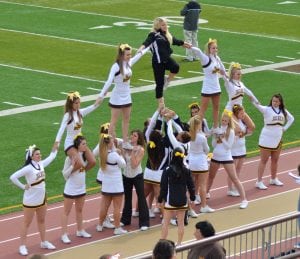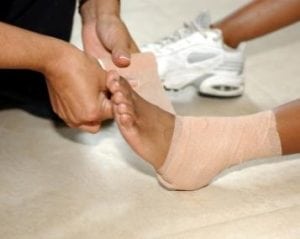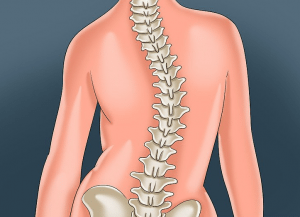When most of us think about Cheerleading, we probably picture a team performing some impressive gymnastic feats at a sports stadium during the half time break. For many participants and spectators alike, this is still the Cheerleading we know and love, but increasingly Cheerleading is also a highly competitive sport in its own right. However, as cheerleaders have evolved from entertainers to athletes, the rate of injury has increased as well – while many cheerleaders take their sport very seriously, often some important considerations around avoiding sports injury in cheerleading haven’t quite caught up. This week let’s look specifically at how cheerleaders can work to avoid injury.
How common are Cheerleading injuries?
Perhaps because cheerleaders are very good at “going on with the show” we often don’t think of cheerleading as a dangerous sport with a high injury rate. In fact, however, a 2005 study reported that “over 50% of all catastrophic injuries in women ‘s sport occurs in cheerleading”[1]. A 2006 study in the journal paediatrics found that “an estimated 208,800 children 5 to 18 years of age were treated in US hospital emergency departments for cheerleading-related injuries during the 13-year period of 1990-2002.”
The study concludes that ”the number of injuries increased by 110% from 10,900 in 1990 to 22,900 in 2002″[2] . In 2007, the U.S. Consumer Product Safety Commission reported that there were over 74,000 cheerleading injuries. During this period, it’s clear that many more women have become interested in cheerleading as a competitive sport or just as an interesting way to keep fit, so its not necessarily the case that cheerleading has become more dangerous – instead it’s likely that more people are getting into the sport, but perhaps are not receiving good injury prevention advice.
Most cheerleading injuries take place during high impact performances involving gymnastic tumbling, or during potentially dangerous manoeuvres such as the pyramid (the cheerleader at the top is most often injured after falling onto a hard surface) or the basket toss (when a cheerleader is thrown into the air by three or four other cheerleaders).
Obviously, these high risk activities do draw the most attention, but injuries – even serious ones – can also occur during simple, basic routines, especially when performed on unforgiving surfaces like gymnasium floors.
Start from a solid foundation
Because cheerleading can put quite significant strain on the body, a thorough chiropractic check-up is an important step before starting to cheer or beginning a new season. Here at the clinic we can rule out any conditions that would put you at higher risk for injury throughout the season and help to significantly reduce your chances of having to sit some, or all, of the season out.
One ailment we will check for is vertebral subluxations – or misaligned spinal bones (vertebrae). This common condition often develops simply as a result of poor posture, or even from frequently carrying heavy bags – meaning it can easily creep in during the off season. Dysfunctional areas affect not only the spine, but can also lead to conditions throughout the body, including problems that could affect a cheerleader’s performance or boost the chances of injury. Thankfully, subluxation can be easily and painlessly corrected through your regular chiropractic care, so be sure to book a session before the season starts – and be sure to keep up your appointments while you’re training.
Notably, chiropractic care also helps establish and maintain optimal posture, which improves balance, and good balance is perhaps the best key to avoiding many cheerleading injuries.
Stretch and strengthen
Being flexible and strong are key to preventing many common cheerleading injuries.
Try splits, lunges and straddles for lower-body stretching. Also pull each arm across the chest to stretch the shoulders and arms. A workout with light weights or calisthenics will increase strength and endurance. Running or jogging will also improve lower body strength and endurance, but be careful about introducing large amounts of running without first getting your chiropractic check-up, since running with postural or gait issues (especially when tired) is a frequent cause of injury.
Ensure cheerleading coaches are highly qualified
When cheerleading for fun, perhaps at a school or club (and so long as no high intensity stunts are being performed) it’s not necessary to seek out an expensive and highly qualified coach – any well-trained sports professional will be more than able to lead a basic exercise group using floor routines or choreographed sessions for fun and exercise. That being said, when cheerleaders are performing high intensity routines, or routines which include dangerous stunts, a properly qualified cheerleading coach is a must.
A 2004 study of cheerleading injuries and their risk factors among high school cheerleaders concluded that cheerleaders supervised by coaches with the most education, qualifications, and training (coach EQT) had a nearly 50% reduction in injury risk … compared to cheerleaders supervised by coaches with low coach EQT.[3] Cheerleaders should never build an elevated or complex stunt without a highly qualified coach present – the coach should also review and approve all stunts, including pyramids and basket tosses, prior to execution. Ideally, look for a coach who is also skilled in first aid specific to cheerleading, and who has links with local rehabilitation professionals such as sports therapists and chiropractors to speed recovery when injury does occur.
Use spotters and mats
A 2003 study of catastrophic cheerleading injuries found that “suggestions for reducing catastrophic injuries in cheerleaders include enhancing the number and training of spotters, mandating floor mats for complex stunts, restricting complex stunts when surfaces are wet, and encouraging safety certification of coaches. Pyramids and basket tosses should be limited to experienced cheerleaders who have mastered all other skills and should be performed with spotters and specialised landing mats.[4]
As moves get more involved, such as lifting other squad members into the air, make sure there are enough spotters and supporters. In addition, always practice on mats. Do jumps, tumbles and other gymnastic moves on mats and pads to drastically reduce the chance of injuries due to falls.
And the most common cheerleading injuries are…
Although cheerleaders are vulnerable to a vast array of injuries, the ankle, wrist and hands seem to be the most vulnerable -at both the high school and college level.
One study of 425 high-school cheer leaders found that “of all injuries, the ankle (24.4%), back (16.1%) and wrist or hand (15.6%) were the most frequent sites of injury.”[5] Another analysis of 440 college cheerleaders found that ankles and wrist/hand were the most frequently injured.[6]
Fortunately, while most people associate chiropractic with the spine, chiropractic care is also a highly effective option for alleviating pain and disability after an ankle or wrist injury.
ln one study, researcher’s divided 30 patients with ankle sprains into two groups: 15 received ankle adjustments, and 15 underwent ultrasound treatment. After eight sessions spanning four weeks, the chiropractic group showed a greater reduction in pain and increased ankle range of motion and function, compared to the ultrasound group[7] .
Longer term problems
Cheerleading, like any high intensity sport, puts the participant at risk of cumulative issues which should be monitored and addressed to ensure longer term problems do not develop. Typical problems for cheerleaders include back pain and neck pain which are often the result of repeated small injuries, or postural problems which develop over long periods of time. Again, chiropractic care is ideal for detecting and resolving these kinds of issues.
Cheerleaders and scoliosis
Scoliosis, a condition which causes a curvature of the spine is found in approximately 2-3% of adolescents. If left untreated, scoliosis can cause significant deformity of the spine, reduce functional capacity and fitness and in some cases eventually requires spinal fusion surgery – which can put an end to a sporting career.
2-3% of children do not necessarily seem like a high number, but when we consider than 75% of scoliosis cases are women and young girls the risk to cheerleaders starts to become more obvious. Recent scoliosis studies involving gymnasts have shown that the risk of scoliosis can be as much as 12 times higher than average in their sport, which, by inference, suggests the risk for cheerleaders could be quite high too.
Thankfully, scoliosis can also be easily detected and treated non-surgically, if proper treatment is sought at the correct time. We are ideally positioned to help those suffering with scoliosis through our sister clinic The UK Scoliosis Clinic. Since June is Scoliosis awareness month, we encourage all our readers (Especially cheerleaders!) to learn more about scoliosis and try our free scoliosis screening tool.
[1] Br J Sports Med 2005;39:237-40
[2] Pediatrics 2006; 1 17:122-9
[3] Am J Sports Med 2004;32:396-405
[4] Am J Sports Med 2003;3 I :881-8
[5] J Orthop Sports Phys Ther 2004;34:261-5
[6] Br J Sports Med 2005;39:237- 40).
[7] J Manipulative Physiol Ther 2001;24:17-24




